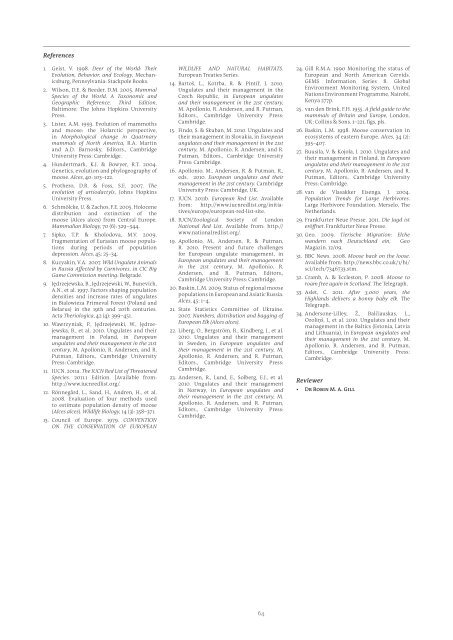130925-studie-wildlife-comeback-in-europe
You also want an ePaper? Increase the reach of your titles
YUMPU automatically turns print PDFs into web optimized ePapers that Google loves.
References<br />
1. Geist, V. 1998. Deer of the World: Their<br />
Evolution, Behavior, and Ecology, Mechanicsburg,<br />
Pennsylvania: Stackpole Books.<br />
2. Wilson, D.E. & Reeder, D.M. 2005. Mammal<br />
Species of the World. A Taxonomic and<br />
Geographic Reference. Third Edition,<br />
Baltimore: The Johns Hopk<strong>in</strong>s University<br />
Press.<br />
3. Lister, A.M. 1993. Evolution of mammoths<br />
and moose: the Holarctic perspective,<br />
<strong>in</strong> Morphological change <strong>in</strong> Quatrnary<br />
mammals of North America, R.A. Mart<strong>in</strong><br />
and A.D. Barnosky, Editors., Cambridge<br />
University Press: Cambridge.<br />
4. Hundertmark, K.J. & Bowyer, R.T. 2004.<br />
Genetics, evolution and phylogeography of<br />
moose. Alces, 40: 103–122.<br />
5. Prothero, D.R. & Foss, S.E. 2007. The<br />
evolution of artiodactyls, Johns Hopk<strong>in</strong>s<br />
University Press.<br />
6. Schmölcke, U. & Zachos, F.E. 2005. Holocene<br />
distribution and ext<strong>in</strong>ction of the<br />
moose (Alces alces) from Central Europe.<br />
Mammalian Biology, 70 (6): 329–344.<br />
7. Sipko, T.P. & Kholodova, M.V. 2009.<br />
Fragmentation of Eurasian moose populations<br />
dur<strong>in</strong>g periods of population<br />
depression. Alces, 45: 25–34.<br />
8. Kuzyak<strong>in</strong>, V.A. 2007. Wild Ungulate Animals<br />
<strong>in</strong> Russia Affected by Carnivores, <strong>in</strong> CIC Big<br />
Game Commission meet<strong>in</strong>g: Belgrade.<br />
9. Jędrzejewska, B., Jędrzejewski, W., Bunevich,<br />
A.N., et al. 1997. Factors shap<strong>in</strong>g population<br />
densities and <strong>in</strong>crease rates of ungulates<br />
<strong>in</strong> Bialowieza Primeval Forest (Poland and<br />
Belarus) <strong>in</strong> the 19th and 20th centuries.<br />
Acta Theriologica, 42 (4): 399–451.<br />
10. Wawrzyniak, P., Jędrzejewski, W., Jędrzejewska,<br />
B., et al. 2010. Ungulates and their<br />
management <strong>in</strong> Poland, <strong>in</strong> European<br />
ungulates and their management <strong>in</strong> the 21st<br />
century, M. Apollonio, R. Andersen, and R.<br />
Putman, Editors., Cambridge University<br />
Press: Cambridge.<br />
11. IUCN. 2011a. The IUCN Red List of Threatened<br />
Species. 2011.1 Edition. [Available from:<br />
http://www.iucnredlist.org/.<br />
12. Rönnegård, L., Sand, H., Andren, H., et al.<br />
2008. Evaluation of four methods used<br />
to estimate population density of moose<br />
(Alces alces). Wildlife Biology, 14 (3): 358–371.<br />
13. Council of Europe. 1979. CONVENTION<br />
ON THE CONSERVATION OF EUROPEAN<br />
WILDLIFE AND NATURAL HABITATS.<br />
European Treaties Series.<br />
14. Bartoš, L., Kotrba, R. & P<strong>in</strong>tíř, J. 2010.<br />
Ungulates and their management <strong>in</strong> the<br />
Czech Republic, <strong>in</strong> European ungulates<br />
and their management <strong>in</strong> the 21st century,<br />
M. Apollonio, R. Andersen, and R. Putman,<br />
Editors., Cambridge University Press:<br />
Cambridge.<br />
15. F<strong>in</strong>do, S. & Skuban, M. 2010. Ungulates and<br />
their management <strong>in</strong> Slovakia, <strong>in</strong> European<br />
ungulates and their management <strong>in</strong> the 21st<br />
century, M. Apollonio, R. Andersen, and R.<br />
Putman, Editors., Cambridge University<br />
Press: Cambridge.<br />
16. Apollonio, M., Andersen, R. & Putman, R.,<br />
eds. 2010. European ungulates and their<br />
management <strong>in</strong> the 21st century. Cambridge<br />
University Press: Cambridge, UK.<br />
17. IUCN. 2011b. European Red List. Available<br />
from: http://www.iucnredlist.org/<strong>in</strong>itiatives/<strong>europe</strong>/<strong>europe</strong>an-red-list-site.<br />
18. IUCN/Zoological Society of London<br />
National Red List. Available from: http://<br />
www.nationalredlist.org/.<br />
19. Apollonio, M., Andersen, R. & Putman,<br />
R. 2010. Present and future challenges<br />
for European ungulate management, <strong>in</strong><br />
European ungulates and their management<br />
<strong>in</strong> the 21st century, M. Apollonio, R.<br />
Andersen, and R. Putman, Editors.,<br />
Cambridge University Press: Cambridge.<br />
20. Bask<strong>in</strong>, L.M. 2009. Status of regional moose<br />
populations <strong>in</strong> European and Asiatic Russia.<br />
Alces, 45: 1–4.<br />
21. State Statistics Committee of Ukra<strong>in</strong>e.<br />
2007. Numbers, distribution and bagg<strong>in</strong>g of<br />
European Elk (Alces alces).<br />
22. Liberg, O., Bergström, R., K<strong>in</strong>dberg, J., et al.<br />
2010. Ungulates and their management<br />
<strong>in</strong> Sweden, <strong>in</strong> European ungulates and<br />
their management <strong>in</strong> the 21st century, M.<br />
Apollonio, R. Andersen, and R. Putman,<br />
Editors., Cambridge University Press:<br />
Cambridge.<br />
23. Andersen, R., Lund, E., Solberg, E.J., et al.<br />
2010. Ungulates and their management<br />
<strong>in</strong> Norway, <strong>in</strong> European ungulates and<br />
their management <strong>in</strong> the 21st century, M.<br />
Apollonio, R. Andersen, and R. Putman,<br />
Editors., Cambridge University Press:<br />
Cambridge.<br />
24. Gill R.M.A. 1990 Monitor<strong>in</strong>g the status of<br />
European and North American Cervids.<br />
GEMS Information Series 8. Global<br />
Environment Monitor<strong>in</strong>g System, United<br />
Nations Environment Programme, Nairobi,<br />
Kenya 277p.<br />
25. van den Br<strong>in</strong>k, F.H. 1955. A field guide to the<br />
mammals of Brita<strong>in</strong> and Europe, London,<br />
UK: Coll<strong>in</strong>s & Sons. 1–221, figs, pls.<br />
26. Bask<strong>in</strong>, L.M. 1998. Moose conservation <strong>in</strong><br />
ecosystems of eastern Europe. Alces, 34 (2):<br />
395–407.<br />
27. Ruusila, V. & Kojola, I. 2010. Ungulates and<br />
their management <strong>in</strong> F<strong>in</strong>land, <strong>in</strong> European<br />
ungulates and their management <strong>in</strong> the 21st<br />
century, M. Apollonio, R. Andersen, and R.<br />
Putman, Editors., Cambridge University<br />
Press: Cambridge.<br />
28. van de Vlasakker Eisenga, J. 2004.<br />
Population Trends for Large Herbivores.<br />
Large Herbivore Foundation. Merselo, The<br />
Netherlands.<br />
29. Frankfurter Neue Presse. 2011. Die Jagd ist<br />
eröffnet. Frankfurter Neue Presse.<br />
30. Geo. 2009. Tierische Migration: Elche<br />
wandern nach Deutschland e<strong>in</strong>, Geo<br />
Magaz<strong>in</strong>. 12/09.<br />
31. BBC News. 2008. Moose back on the loose.<br />
Available from: http://news.bbc.co.uk/1/hi/<br />
sci/tech/7346733.stm.<br />
32. Cramb, A. & Eccleston, P. 2008. Moose to<br />
roam free aga<strong>in</strong> <strong>in</strong> Scotland. The Telegraph.<br />
33. Aslet, C. 2011. After 3,000 years, the<br />
Highlands delivers a bonny baby elk. The<br />
Telegraph.<br />
34. Andersone-Lilley, Ž., Balčiauskas, L.,<br />
Ozoliņš, J., et al. 2010. Ungulates and their<br />
management <strong>in</strong> the Baltics (Estonia, Latvia<br />
and Lithuania), <strong>in</strong> European ungulates and<br />
their management <strong>in</strong> the 21st century, M.<br />
Apollonio, R. Andersen, and R. Putman,<br />
Editors., Cambridge University Press:<br />
Cambridge.<br />
Reviewer<br />
• Dr Rob<strong>in</strong> M. A. Gill<br />
64


